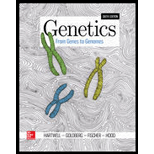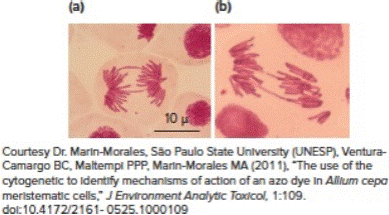
Concept explainers
In the 1920s, Barbara McClintock, later a Nobel laureate for her discovery of transposable elements, examined the behavior of chromosomes in wheat cells that had been subjected to X-rays. She noticed that the X-rays produced chromosomal breaks during G1 phase, and that after subsequent chromosome replication in S phase, the broken ends of the two sister chromatids could join together to make a fusion chromosome larger than the original. Even later, during mitotic metaphase and early in mitotic anaphase, the joined sister chromatids would form an unusual bridge structure in which chromatin was stretched between the two spindle poles and could then eventually break. She called this phenomenon the breakage-fusion-bridge cycle. Each of photographs (a) and (b) that follow shows a cell in early mitotic anaphase that has two such chromatin bridges.

| a. | What ensures that the ends of normal chromosomes do not fuse together as do the ends of the sister chromatids after breakage? |
| b. | The following figure shows a chromosome with genes A–G; the arrow indicates the location of X-ray induced breakage. Draw the resulting bridge (that is, the large fused chromosome) as it would be seen in mitotic anaphase, and label all the genes and important chromosomal structures the bridge contains. Use arrows to show the forces exerted by the spindle apparatus on this bridge.  |
| c. | If the sister chromatids fuse, why must the fusion chromosome behave as a bridge during mitosis? [Think about the forces pulling on the bridge described in your answer to part (b).] |
| d. | What is likely to happen to the bridge during mitotic anaphase? What then is likely to happen in the two daughter cells produced by the mitosis just described, and why? (Hint: McClintock’s name for this phenomenon implies it is a cycle.) |
Want to see the full answer?
Check out a sample textbook solution
Chapter 12 Solutions
Genetics: From Genes to Genomes
- Noggin mutation: The mouse, one of the phenotypic consequences of Noggin mutationis mispatterning of the spinal cord, in the posterior region of the mouse embryo, suchthat in the hindlimb region the more ventral fates are lost, and the dorsal Pax3 domain isexpanded. (this experiment is not in the lectures).a. Hypothesis for why: What would be your hypothesis for why the ventral fatesare lost and dorsal fates expanded? Include in your answer the words notochord,BMP, SHH and either (or both of) surface ectoderm or lateral plate mesodermarrow_forwardNot part of a graded assignment, from a past midtermarrow_forwardNot part of a graded assignment, from a past midtermarrow_forward
- please helparrow_forwardWhat does the heavy dark line along collecting duct tell us about water reabsorption in this individual at this time? What does the heavy dark line along collecting duct tell us about ADH secretion in this individual at this time?arrow_forwardBiology grade 10 study guidearrow_forward
 Human Heredity: Principles and Issues (MindTap Co...BiologyISBN:9781305251052Author:Michael CummingsPublisher:Cengage Learning
Human Heredity: Principles and Issues (MindTap Co...BiologyISBN:9781305251052Author:Michael CummingsPublisher:Cengage Learning Human Biology (MindTap Course List)BiologyISBN:9781305112100Author:Cecie Starr, Beverly McMillanPublisher:Cengage Learning
Human Biology (MindTap Course List)BiologyISBN:9781305112100Author:Cecie Starr, Beverly McMillanPublisher:Cengage Learning Biology (MindTap Course List)BiologyISBN:9781337392938Author:Eldra Solomon, Charles Martin, Diana W. Martin, Linda R. BergPublisher:Cengage Learning
Biology (MindTap Course List)BiologyISBN:9781337392938Author:Eldra Solomon, Charles Martin, Diana W. Martin, Linda R. BergPublisher:Cengage Learning Biology: The Dynamic Science (MindTap Course List)BiologyISBN:9781305389892Author:Peter J. Russell, Paul E. Hertz, Beverly McMillanPublisher:Cengage Learning
Biology: The Dynamic Science (MindTap Course List)BiologyISBN:9781305389892Author:Peter J. Russell, Paul E. Hertz, Beverly McMillanPublisher:Cengage Learning Concepts of BiologyBiologyISBN:9781938168116Author:Samantha Fowler, Rebecca Roush, James WisePublisher:OpenStax College
Concepts of BiologyBiologyISBN:9781938168116Author:Samantha Fowler, Rebecca Roush, James WisePublisher:OpenStax College





